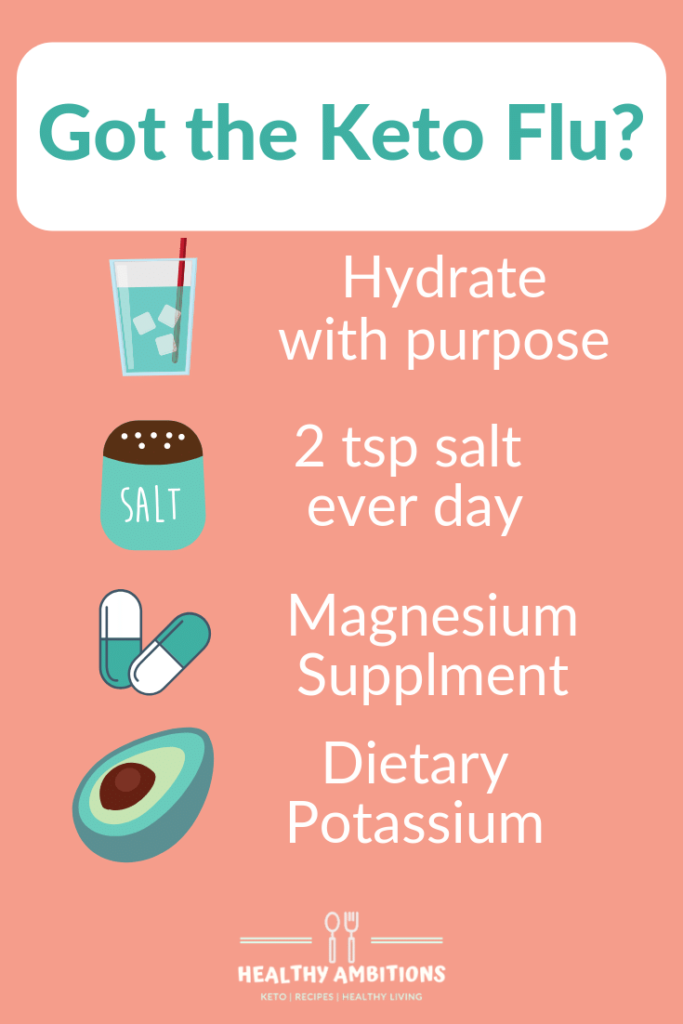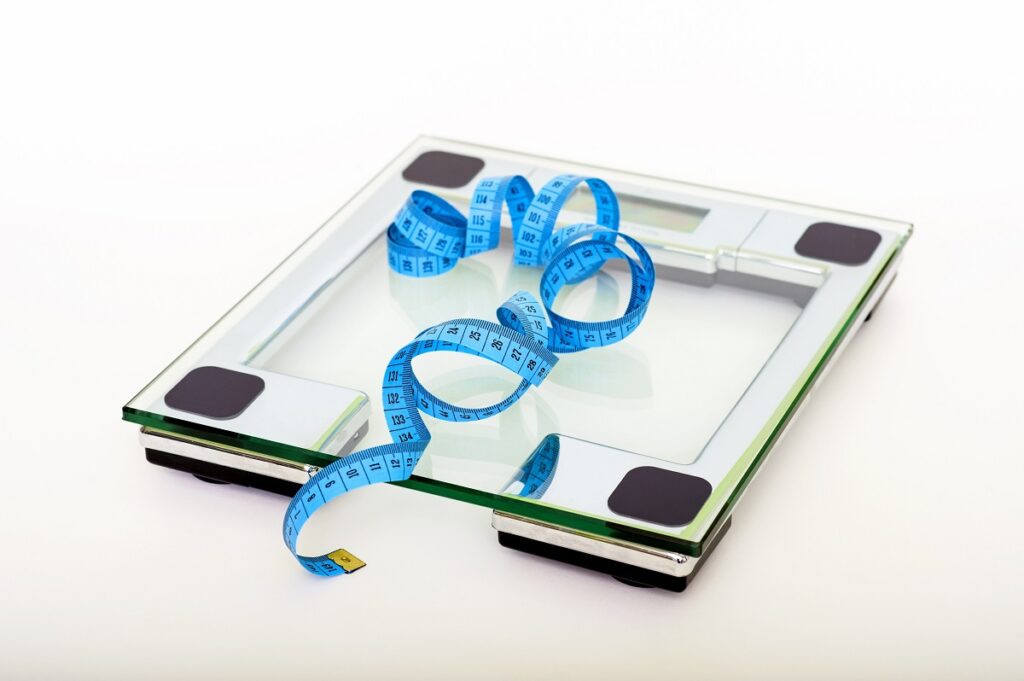The Keto Flu: Why it Happens and How to Overcome It
This post may contain affiliate links, which helps keep this content free. Please read our disclosure for more info.
What is the Keto Flu?
What causes the keto flu? Can you avoid the keto flu? What’s the quickest way to get past the keto flu? These are just a few of the questions I see every day from those starting the ketogenic diet.
The level of symptoms for the keto flu varies widely from one person to the next, and for a very good reason. To understand why Person A exhibits zero keto flu symptom while Person B feels like they are on their death bed, it’s important to understand what causes the keto flu.
Simply put, the keto flu results from your body going through withdrawals from sugar and carbohydrates. Since your body turns carbohydrates into glucose (a.k.a. sugar) for energy, it really comes down to a sugar-withdrawal.
Individuals that previously ate a Standard American Diet (SAD) or indulged in a carb-heavy diet seem to suffer the most. The more extreme the elimination (previous amount of carbs vs new amount of carbs), the worse the withdrawal symptoms.
What Are Keto Flu Symptoms?
You may experience some of all of the following symptoms during the carb-withdrawal period known as the keto flu.
- Fatigue
- Headache
- Muscle Cramps
- Light-Headed
- Increased Heart Rate
- Nausea
- Mental Fog
- Irritable / Moody / Depressed
- Bad Breath
- Dry Mouth
- Constipation

You will have to muscle through many of these symptoms while your body detoxes from sugar and carbs, no different than any type of withdrawal. But there are a few things you can do to alleviate some of the symptoms.
Alleviate Keto Flu Symptoms – Keto Flu Remedies
Carbohydrates retain water in the body, so when you eliminate them, you experience a significant water loss.
This explains why some people have amazing weight loss results the first week on the keto diet, but it’s important to keep in mind that it’s mostly water.
The problem with your body flushing out so much water is that much-needed electrolytes are flushed out too. An electrolyte imbalance can lead to fatigue, irritability, and depression…just to name a few.
Unfortunately, simply drinking more water won’t be enough. In addition to drinking plenty of water, you must also replenish those electrolytes.
Your body’s electrolytes are made up of several essential minerals, but for the purpose of the keto flu, we will focus on three specific minerals: Salt, Magnesium, and Potassium
Salt

I think most of us grew up hearing that too much salt is bad for our health. And for anyone on the Standard American Diet, this is very true. Processed foods include an enormous amount of added salt.
When you remove processed foods from your diet and move to a healthy Whole Food Diet, you can actually find yourself with a salt deficiency. That’s why increasing your salt intake is one of the common answers to the question of how to get over the keto flu.
For a whole-food ketogenic diet, it’s recommended that you get 2 tsp of pink salt (or sea salt) per day. Some people like to measure out 2 tsp in the morning and add it to their food and drinks throughout the day to ensure they get the proper amount.
A few symptoms of salt deficiency include nausea, headache, confusion, fatigue, and irritability. So if you are experiencing any of these symptoms, increase your salt intake.
Magnesium
The majority of Americans are deficient in magnesium today. Due to the ever-popular bottled water industry, we no longer drink magnesium naturally found in water because it’s filtered out. And our food supply is no longer rich in magnesium because we have depleted the soil through farming.
You’ll find lots of different magnesium supplements on the market, but there are a few you should stay away from if you have tummy issues. Magnesium Citrate and Magnesium Oxide are known to have a laxative effect. So, unless you are constipated, stay away from these supplements.
The BEST option is Magnesium Glycinate which helps improve sleep, anxiety, and pain.
A few symptoms of a magnesium deficiency include anxiety, insomnia, low energy, muscle cramps, high blood pressure, and hormonal imbalances such as PMS.
I recommend taking 200 mg in the morning and 200 mg before bed, although some people take up to 400 mg twice a day.
If you are prone to tummy issues, you may want to look into a topical magnesium supplement.
Potassium
Most people will get enough potassium in their diet, and you only need to supplement as a last resort. Foods such as beef, avocados, salmon, and leafy greens are great sources of potassium.
A few symptoms of potassium deficiency include muscle cramps, digestive issues, irritability, and constipation.
Since you can so easily meet your body’s potassium requirements through a keto diet, do not take a pill unless you really need to.

My Favorite Way to Replenish Electrolytes
You can easily replenish your electrolytes by adding more salt to your food and taking supplements for magnesium and potassium.
Another option is to make a homemade electrolyte drink using 8 ounces of water, 1/4 teaspoon of pink salt, and 1/4 teaspoon of NoSalt (potassium)….but you won’t enjoy it, lol
OR, you can add a super tasty electrolyte drink to your daily routine.
I personally drink Key Nutrients every single day.
If you would like to read my full review of Key Nutrients, you can check out my article on The Best Keto Electrolytes!
In Summary
The Keto Flu usually hits in the first week or two. Your level of symptoms, if any, will greatly depend on your diet before starting the ketogenic diet. If you had a heavy carb and sugar diet before, your body will have to go through a detox, ushering in withdrawal symptoms.
The best way to alleviate some of the symptoms is to make sure you stay hydrated, add 2 tsp of salt to your diet every day, take a magnesium supplement, and ensure to include potassium-rich foods on your plate.
Related: Read about my family’s keto diet success.
The 3 Phases of the Keto Diet?
The Keto Diet has 3 phases to it.
Phase 1 is where you drastically cut your carb intake, ideally to no more than 20 grams a day. This is when you will most likely experience some level of the keto flu. Within 2-3 days your body will begin to produce ketones, but you are not an efficient fat-burner yet. You are just starting the process.
Phase 2 is where you become fat-adapted (or keto-adapted). This takes 4-6 weeks to achieve, but once you become fat-adapted, you will see a significant increase in your energy level. A sudden burst of energy is a good sign that your body is now efficient at burning fat for fuel.
Phase 3 is where you continue to see improvements to your health over time. Many people continue to notice changes and improvements to their health at 6 months in, 12 months in, and beyond. This takes keto beyond weight loss and into your overall health.
The longer you stick with the keto diet, the more you will see the benefits. I encourage you to look at this as a lifestyle change, and not just a diet to lose weight. There are so many benefits that go beyond weight loss.

Breakfast Beyond Eggs and Bacon
Its common for people to get tired of eating eggs for breakfast all the time, so I wanted to share with you some of my favorite “non-egg” breakfast options that are totally keto-friendly!
Keto Monkey Bread (there’s a fine line between dessert and breakfast with this one)
Keto Cinnamon Toast (with my favorite bread recipe)
Have you suffered from the keto flu? Tell me about your experience in the comment section below.



